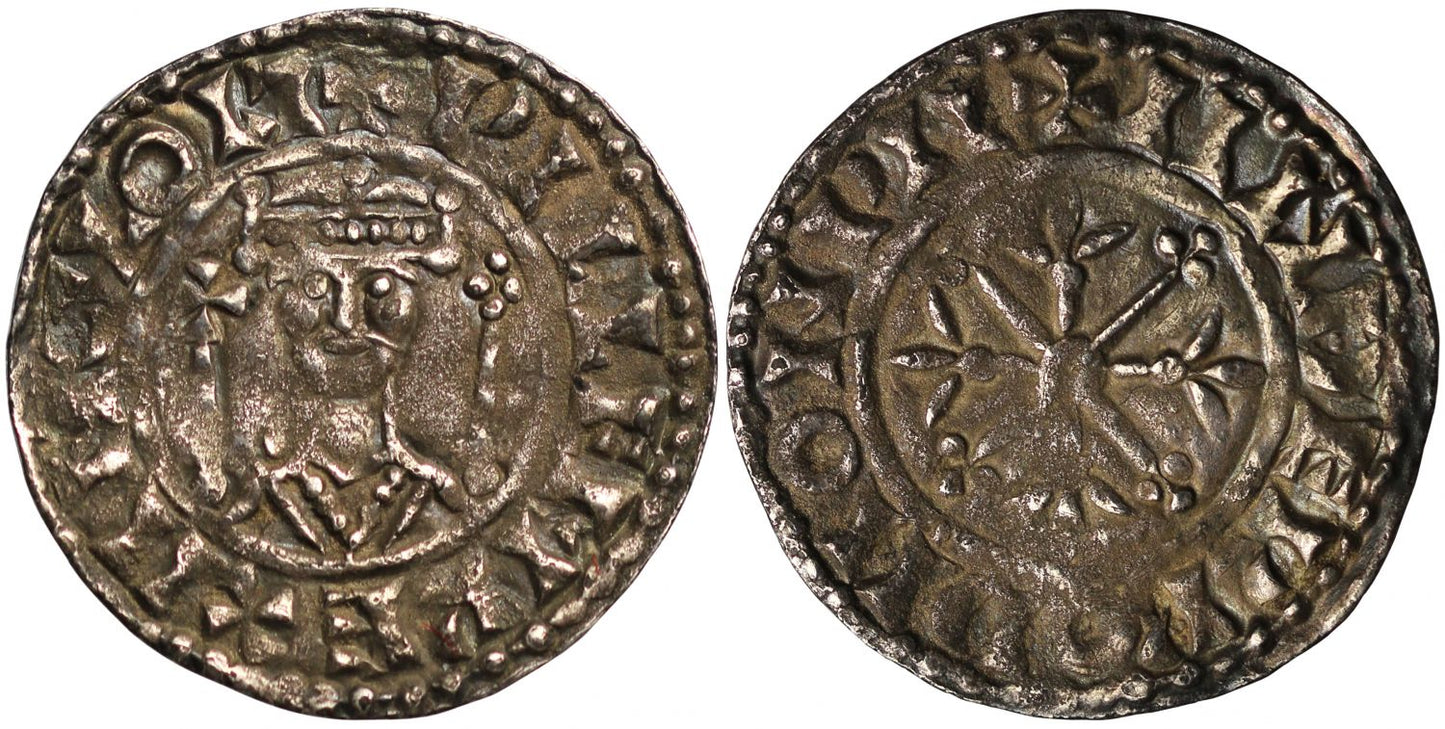FAQs
What makes a coin valuable?
I have coins to sell, what’s the next step?
How will my purchases be shipped?
What happens if I’m not entirely happy with my purchase?
William I Penny, Two sceptres type, Winchester Mint, Moneyer Anderboda
William I (1066-87),silver Penny, two sceptres type (1072-74?), Winchester Mint, moneyer Anderboda, facing crowned bust with sceptre each side, all within linear circle, Latin legend commences at top with outer beaded circle surrounding both sides, +PILLEM REX ANGLORI,rev.annulet at centre of cross fleury over saltire bottonnée, +IINDERRODII ON PN, weight 1.39g (SCBI 12:75 Ashmoleon; BMC type IV 284; N.844; S.1253).Toned and struck from rusty dies, weak in parts, about very fine and very rare.
The legends translate as "William King of the English" on obverse and "Anderboda of Winchester" on the reverse.
Despite the transition from the Anglo-Saxon to the Norman period, numismatically the three-year change of coin types continued. The sceptre type of William is the fourth of the seven types attributed to this reign. According to North the Winchester Mint in Hampshire had up to 14 moneyers active throughout the reigns and types of William the Conqueror and William Rufus.
The first Norman King of England, William the Conqueror born around 1028 was the son of Robert I of Normandy and Herleya. A descendant of Rollo, William became Duke of Normandy in 1035, he subsequently married Matilda of Flanders in the 1050s ensuring a powerful ally in that neighbouring region. After a protracted struggle and quashing rebellions, his hold over Normandy was eventually secure by 1060 and with appointment of supporting abbots and bishops in the Norman church, and he subsequently secured the region of Maine in 1062. William's first cousin once removed was the childless Edward the Confessor of England and from this family connection and that Edward had previously told him he would succeed, he assumed a claim to the throne of England over Harold Godwinson, who Edward had named as his successor on his deathbed in January 1066. William also claimed that Harold previously had promised the throne to him in the event of succession, Harold having sworn over holy relics in William's presence as depicted in the Bayeux tapestry. William therefore built up a powerful invasion force to cross the channel and fight for the right to rule England as of September 1066. He landed at Pevensey Bay and after setting up camp with a basic fort at Hastings he marched north to meet Harold at Senlac Hill at Battle, East Sussex on the 14thOctober. A battle raged for most of the day, with at one point a rumour spread that William was slain resulting in him having to remove his helmet and reveal he was alive and fighting, boosting the morale of the Normans for the final onslaught in which Harold perished, either from an arrow in the eye or cut down by a horseman. William then went on a military tour to put down local uprisings leading to his crowning in Westminster Abbey on Christmas Day. He made arrangements in London for governance for whenever he would be in Normandy, and by 1075 his hold on England was almost complete with many forts and castles constructed. His later years involved quelling other uprisings in Europe and difficulty with his eldest son Robert Curthose, but his most famous achievement in England was the preparation of the Domesday Book in 1086; a survey of the land and the land-owners and nobles within it, listing pre-conquest and current holders at that time. William died in September 1087 leading a campaign in northern France and was buried at Caen. Normandy was given to eldest son Robert, with England given to his next surviving son William Rufus.
The City of Winchester on the River Itchen in Hampshire was the Capital of the West Saxon Kingdom and seat of their bishop and mentioned in the Burghal Hidage. The Royal Treasury was here with coinage perhaps struck here as early as the reign of Beorhtric, the first time the mint name appears is on a Penny of Alfred the Great. The town was stormed by Danes in 860 and submitted without resisting to Swein in 1013. Henry of Blois was Bishop of Winchester in the reign of Stephen and the town visited by Matilda proclaimed as "Lady and Queen of England" in 1141, though she later had to flee as it was burnt. Later King John was driven from Winchester in 1216.
Provenance:
Ex Spink Coin Auction 15th July 2015, lot 394.
Ex AMR Coins circa 2018.
FAQs
What makes a coin valuable?
I have coins to sell, what’s the next step?
How will my purchases be shipped?
What happens if I’m not entirely happy with my purchase?













